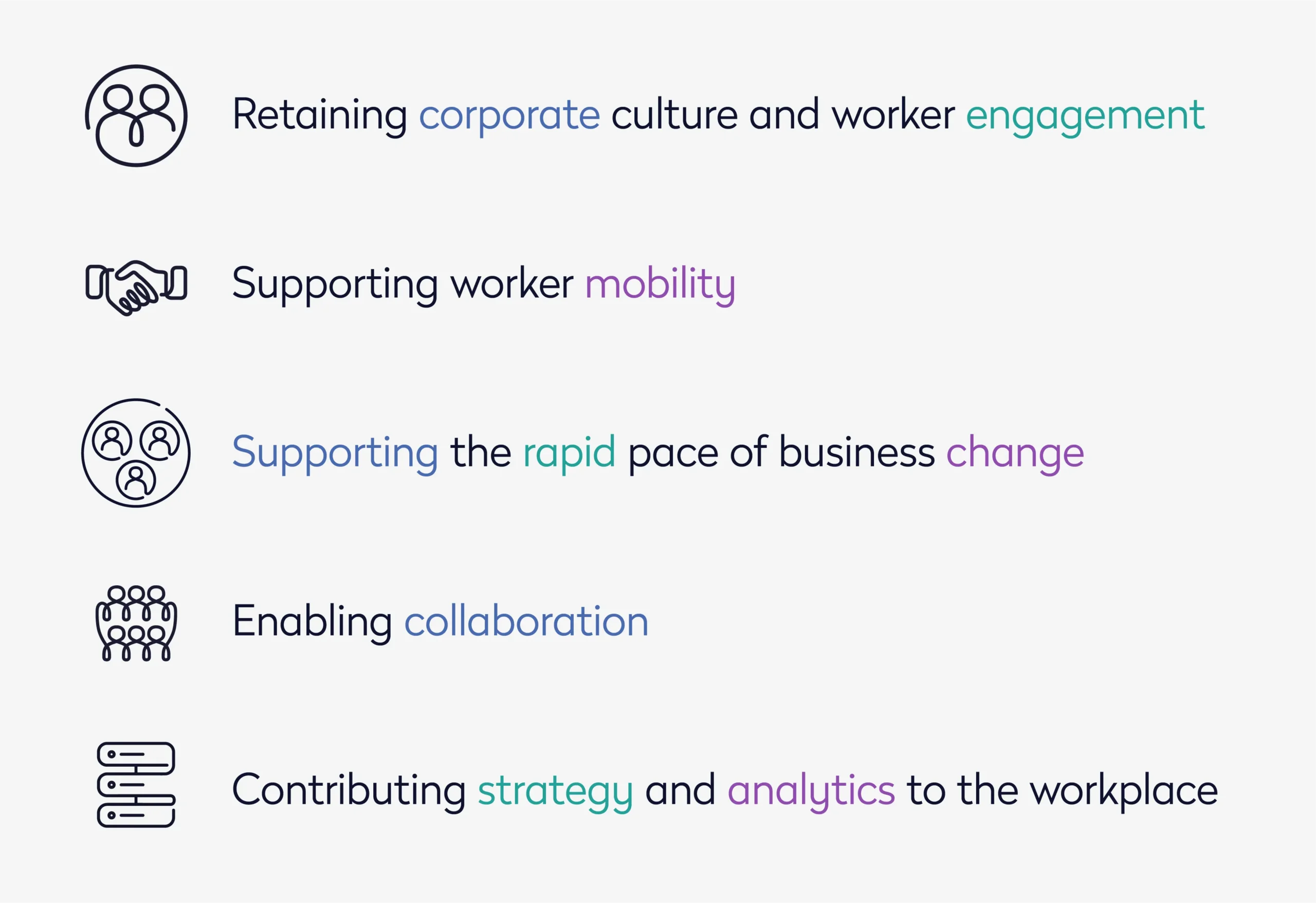
By whatever name you call it: the gig economy, shared economy, or contingent economy, the shift that has led to the growth of on-demand services like Uber and Airbnb is increasingly impacting the global workforce.
“Gig” workers work on a contingent basis: consulting, freelance or temporary. Their number has risen dramatically in the past decade. The increase ramped up around 2007 during the global economic downturn, and by many accounts, gig workers now represent a third of the workforce.
In 2023, 36% of workers are part of the gig economy. 76% of gig workers reported they are satisfied with their career choice. By 2027, current economic statistics estimate that gig workers will comprise over 50% of the workforce.
JLL, a leading professional services firm that specializes in real estate and investment management, has defined the “Liquid Workforce” that promises to impact CRE strategy significantly.
Peter Miscovich, a Global Future of Work Leader for JLL, predicts Enterprise Liquid Workforce platforms will soon be based upon the emerging ‘Hollywood Model’ of working where agile and liquid knowledge workers will be intelligently organized via the Internet on a project basis — similar to how Hollywood movies are made today. Liquid Workforce will be organized via crowdsourced “uber-like” cloud-based work platforms providing greater workforce and workplace efficiency.
The rise of the Liquid Workforce and the gig economy makes one thing clear: the nature of work is changing, and corporate workplaces must be prepared to support that change.
The gig economy: why it’s gaining ground
The rapidly expanding gig economy is not merely a response to changing economic conditions. Here are just a few of the reasons that workers are choosing to work on a contingent basis and companies are choosing to hire more contingent workers:
Benefits of the gig economy for workers:
- Working on projects for multiple companies simultaneously can help to grow skillsets and expose workers to more opportunities
- More independence through flexible work and the freedom to choose when and where to work
- Less risk of job and income loss with multiple employers
- In some fields, gig workers can earn more while working less than their full-time equivalent (FTE) counterparts
Supporting the gig economy: 5 challenges for companies and for CRE
The changing nature of work and the gig economy pose new challenges for corporations, especially in planning and managing corporate real estate. That’s because today CRE groups are expected to do much more than provide every worker with a desk and maintain the space. They must create an environment that supports and contributes to meeting company goals.
1. Retaining corporate culture and worker engagement
How can you build and retain the desired corporate culture when 30 to 50% of your workforce are not employees? Working on a contingent basis may impact worker attitudes, especially relating to their commitment to the company’s long-term needs.
Addressing this concern starts with demonstrating a commitment to all workers, whether employees or gig workers. It’s important to realize that in the gig economy, people who move on to work elsewhere may return in new roles later on. Consultants may return as long-term employees, and employees who leave may return as contractors or customers. When all workers are supported, they are more likely to be committed to company goals and even act as ambassadors after they move on.
CRE can go a long way toward supporting this mindset by providing environments that encourage all workers in the gig economy to feel like part of the team.
2. Supporting worker mobility
It’s no secret that corporate employees are increasingly mobile, often by choice. People work from home, in coffee shops, and on the road, as it suits their responsibilities, schedule, and lifestyle. Contingent workers may not have a choice since they may not have a permanent desk to work from.
CRE can support gig economy workers by providing technology that helps them stay connected and efficient (such as wayfinding technology). Even better, moving toward shared, agile workspaces — that accommodate more people with less space — can make it possible and even desirable for contingent workers to spend more time in the office. Agile workspaces also accommodate a greater range of daily fluctuation in worker attendance without spending more on space.
3. Supporting the rapid pace of business change
One of the advantages of the gig economy for corporations is the ability to scale the workforce up and down as needed to respond to changing business goals. For example, companies can quickly assemble a new team to meet a business need by using contingent workers hired on a project basis. Moving gig workers with a particular skillset between business teams for short-term work is also easier.
CRE groups must be poised to respond to the rapidly changing structure of business teams in the gig economy. That means being ready to move and rearrange office spaces at the drop of a hat. It means implementing technology that makes it faster and easier to manage churn. Another strategy is creating spaces with mobile and adjustable furniture that can transform to meet the team’s changing needs.
4. Enabling collaboration
Just about everyone agrees that collaboration is a demand in the modern workplace. That’s because teamwork generates more and better ideas, driving the innovation needed to be competitive in the global economy. Increasing collaboration in the gig economy can be even more challenging when teams are constantly in flux, and people don’t know each other as well.
To encourage more impromptu collaboration within and between teams, CRE groups must provide appropriate collaborative spaces. That means understanding the spaces people need: is it more 10-person conference rooms or breakout spaces for 2 or 3?
It’s also essential to provide perks and features that make people want to enter the office, such as gyms and coffee lounges. CRE must provide the office design and technology that helps people get more work done, like quiet phone booths, smart whiteboards, and comfortable team huddle areas.
5. Contributing strategy and analytics for the workplace of the future
CRE professionals will need to grow beyond their traditional roles to support the growing gig economy effectively. It’s now essential that CRE work closely with business units and contribute a voice to the company’s strategic vision.
Understanding how people use space (and want to use space) and developing appropriate workplace strategies that align with company goals requires the ability to measure and analyze. For example, creating agile workspaces is a key strategy for optimizing the use of the workspace and meeting all the challenges described here. However, implementing that strategy requires detailed and timely data about how space is used and who is using it.
Utilization technologies provide the means to track that data, and the right workplace management system provides the context and the ability to glean intelligence for decision-making.
There’s no question that the gig economy adds complexity to managing corporate real estate. New skills and strategies are needed, which depend on delivering reliable and flexible business intelligence.








